Best Homemade Pizza Dough Recipe (Authentic Neapolitan Style)
The best homemade pizza dough recipe is in your hands. If you’ve ever been to Southern Italy (the home of pizza), this will take you back to the pizza you ate there. Trust me on this; you’ll be thanking me later!
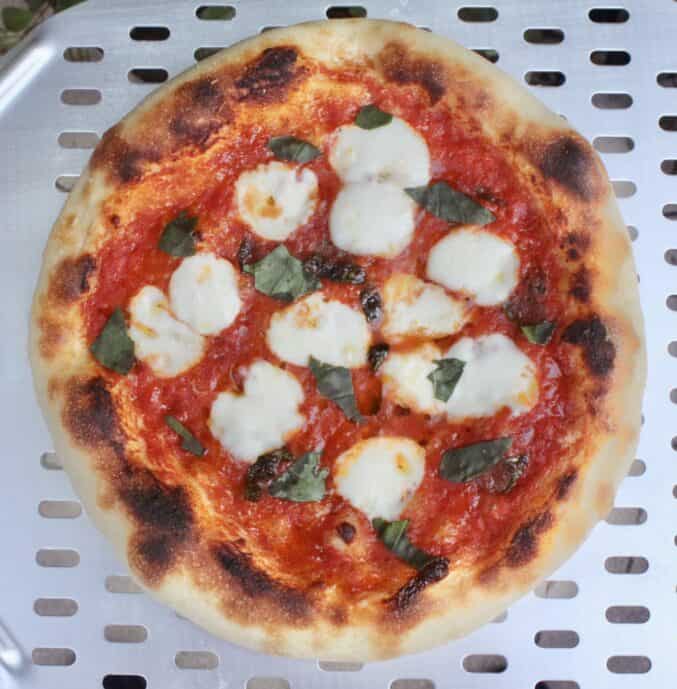
My original pizza dough recipe was published May 4, 2012.
Homemade pizza dough isn’t a difficult thing to make at all. Like any other kitchen creation, the end result will depend on which recipe and which ingredients you choose to use.
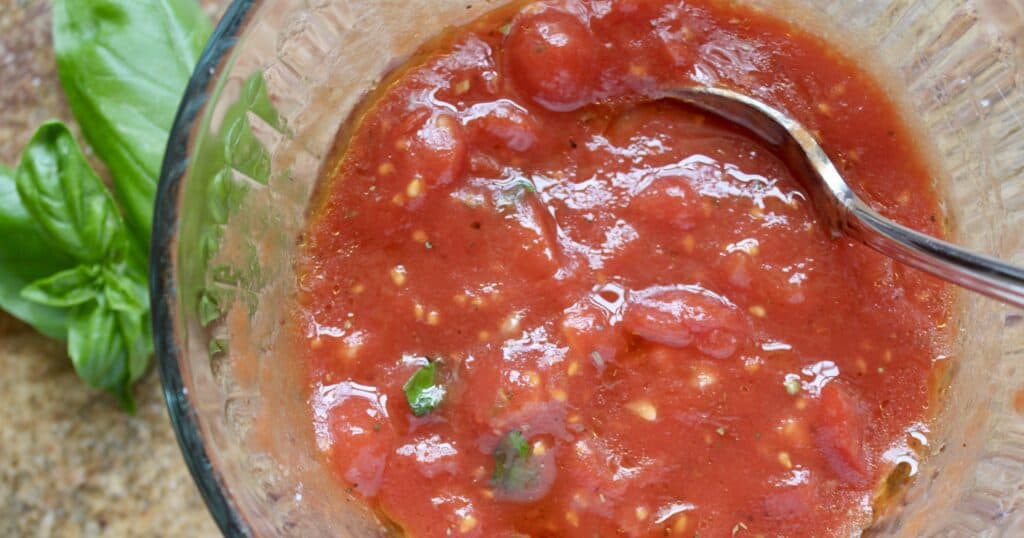
As an Amazon Associate I earn from qualifying purchases.
This is the single most important decision you will always make when cooking or baking. My site isn’t a huge collection of my own recipes, but a collection of others’ recipes that have worked marvelously for me, and I pass them on to you! Although I’ve been making pizza almost all my life, I would never consider myself worthy of sharing a fabulous homemade Neapolitan pizza recipe.

So allow me to introduce you to the recipe’s author (who learned from his father, who was also a master pizza maker in Italy), Maestro Pizzaiolo Vito Iacopelli. His is the best pizza dough recipe you will ever find.

Maestro means “teacher” in Italian, and a “pizzaiolo” is a pizza maker from Southern Italy, so why on earth would you use any other homemade pizza dough recipe? Just like you’d want a recipe for jambalaya from a source in Louisiana, why would you want your pizza recipe from anywhere but the best Italian source?

I have had the pleasure of meeting Vito several times here in Los Angeles, I’ve watched his video tutorials, and even purchased his Masterclass on pizza-making. He is the best teacher and absolutely a riot to watch! He’s so passionate about pizza, you won’t believe it, and that’s why I want to tell you all about him and share his recipe.

Honestly, this pizza dough recipe will change your life (Vito says this, and it’s true)! Pair it with this pizza sauce recipe (which is the same as Vito and all other pizza chefs use in Southern Italy) and your homemade pizza-making skill will improve exponentially! Vito gives all the secrets to what makes authentic Italian pizza so much healthier than American-style pizza.
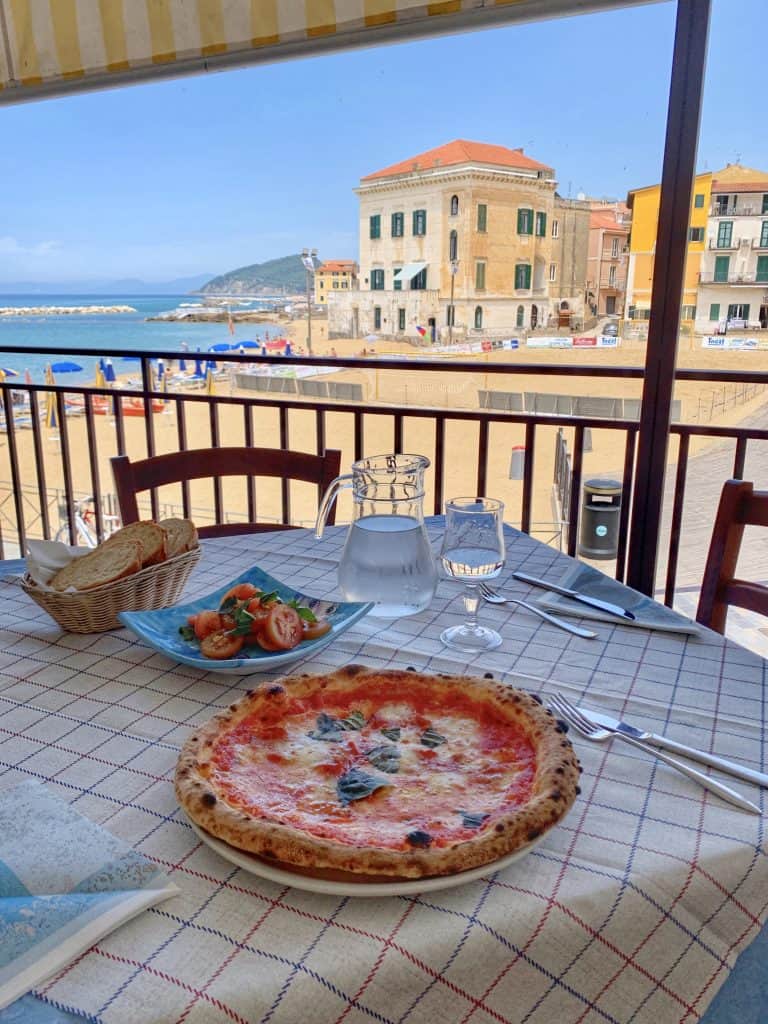
Last September I had a pizza-making lesson at medeaterranea Accademia Enogastromica in Naples, Italy. Master Pizzaiolo Mimmo Onze gave our press trip participants a class on making authentic Neapolitan pizza. Vito’s recipe is practically identical to the one Mimmo had us use because pizza-making has been perfected in Naples.

Guess what? You probably won’t be surprised to hear that using the best quality ingredients is key in this recipe, too. What makes the pizza so different? Besides the quality of ingredients, the way that the dough is made will make the pizza so much more easily digestible.
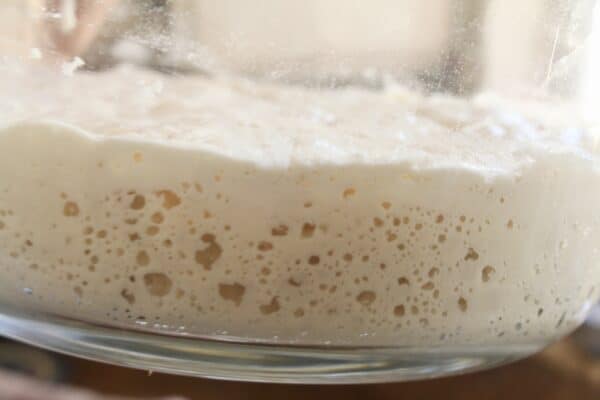
What is Poolish?
A pre-fermented dough called poolish is what is used to make this Neapolitan style homemade pizza dough. It’s not difficult to make at all, and takes only a minute or two to prepare. What you do need to do is plan ahead to make this pizza dough, that’s all. Once you have the poolish ready, it’s just a matter of following Vito’s step by step directions for the perfect pizza dough!
I need to remake my potato pizza using Vito’s homemade pizza dough recipe!
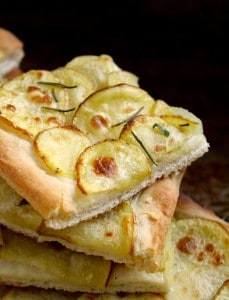
I encourage you to watch the video for this recipe (I’ve linked to it below) and subscribe to Vito’s YouTube channel. He has so many pizza-making videos so you can keep learning and improving.
If you need an easier recipe, look no further than this no knead pizza dough recipe.
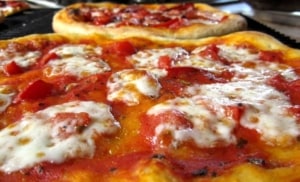
My pizza is far from perfect, but I can’t tell you how much better it is than before I started using Vito’s homemade pizza dough recipe!

If you don’t like a super thin Neapolitan style pizza, just keep the center of the dough a wee bit more thick, and you’ll have a more Roman-style pizza (thicker bottom crust).
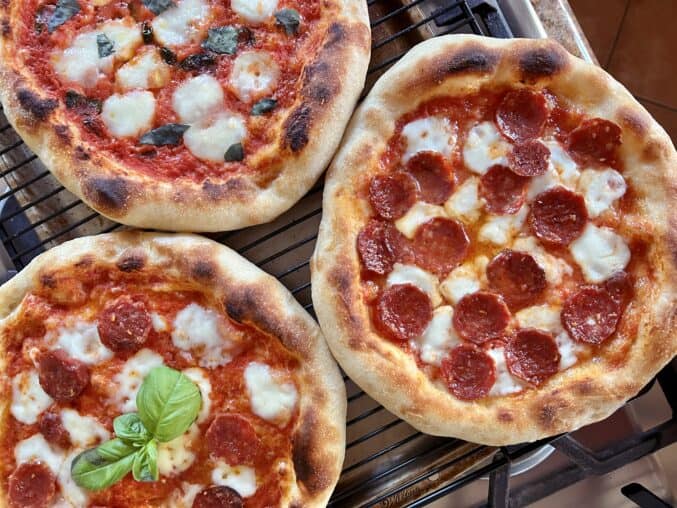
IMPORTANT: I have already received several email requests to add the ingredients in cups. I usually do this with almost all of my recipes, but if it means the recipe will fail, I refuse (like my doughnut recipe and this pizza dough). You will NEVER find a pizza chef in Italy measuring their ingredients with cups, just as you will never find a French pastry chef using them. THEY ARE IMMENSELY INACCURATE. Please spend what it costs for a couple of coffees to invest in a scale. I promise, they are easier to use than cups!
The Best Homemade Pizza Dough Recipe
Very slightly adapted from Maestro Pizzaiolo Vito Iacopelli Makes Five 12″ pizzas
FULL PRINTABLE RECIPE BELOW
PLEASE DO NOT ASK ME TO CONVERT TO CUPS, PLEASE BUY A SCALE INSTEAD SO THE RECIPE WORKS. Vito (and all other chefs) does/do not use cups for a reason: they are inaccurate.
Poolish
- water
- 00 Italian flour (double zero flour is the best for pizza-making, and I highly recommend it) or organic, non-bleached/bromated all-purpose or bread flour, but this won’t be as good as Italian flour
- dry yeast
- honey
Dough
- water
- poolish (after 24 hours)
- 00 Italian flour
- Kosher or sea salt
I recommend starting the poolish a few hours before the time you want to enjoy your pizza the next day. For example, start it on Friday afternoon if you want to have pizza for dinner on Saturday.
Make the Poolish
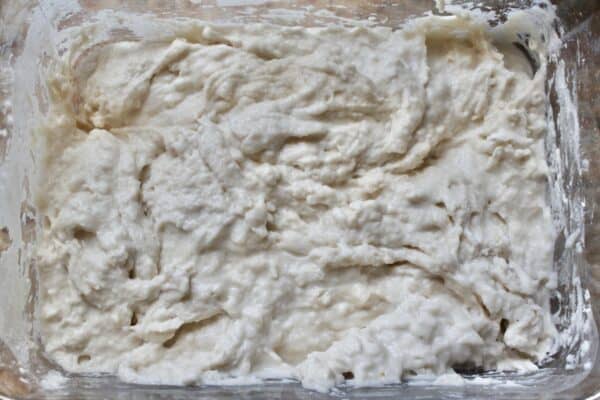
Mix all the poolish ingredients together in a small glass or plastic container until it has a uniform consistency. Leave at room temperature for one hour, then place in the fridge for 24 hours. After a day, it will look like this.
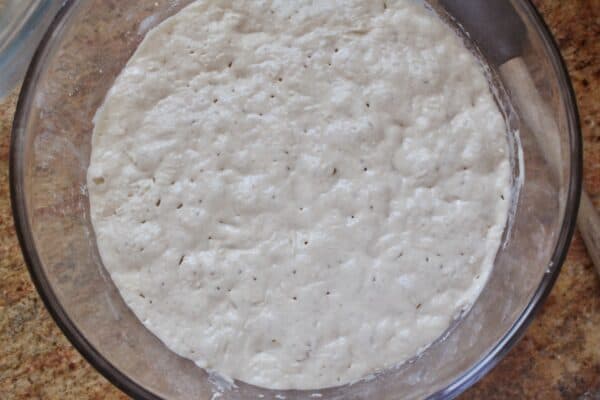
THE NEXT DAY: Make the Dough
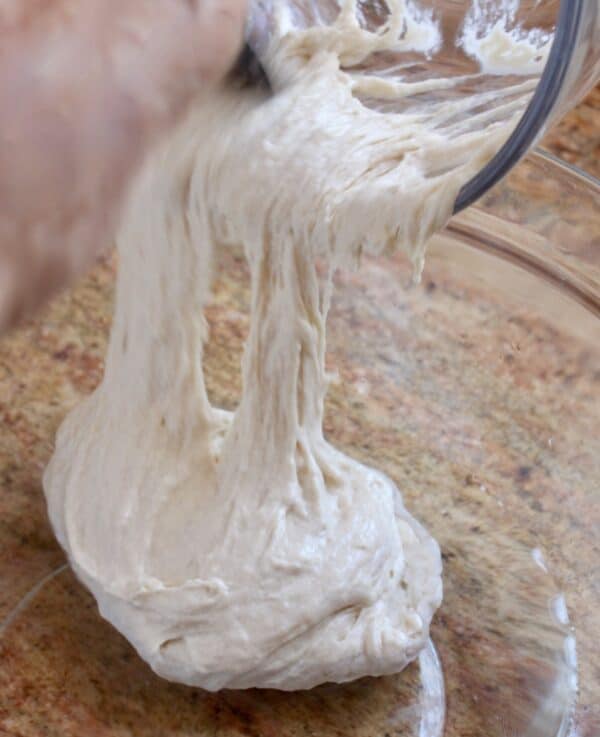
Put the water for the dough into a large bowl then add all of the poolish. Mix together until the poolish loosens and mixes into the water.
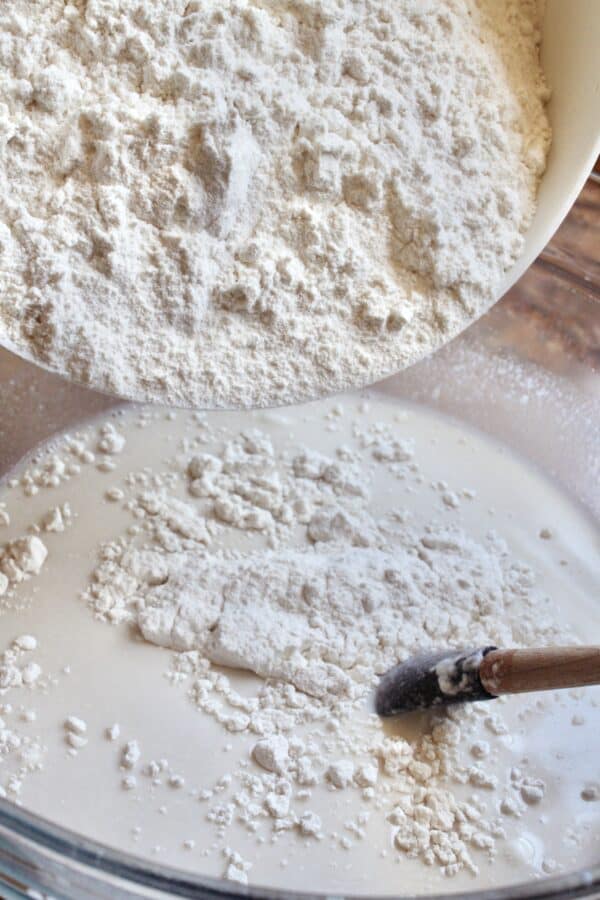
Next, add half of the flour and mix well (I like to use a Danish whisk).

Add the salt.
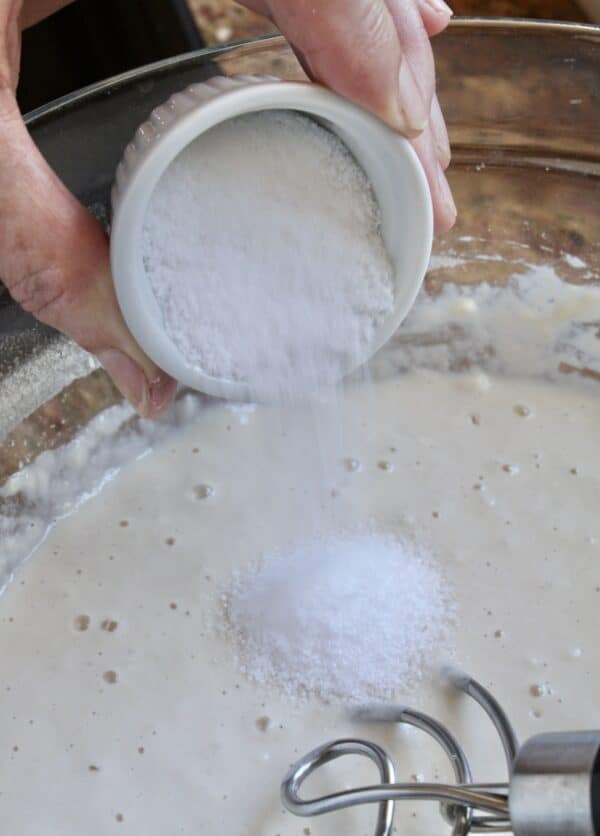
Then add the remaining flour.
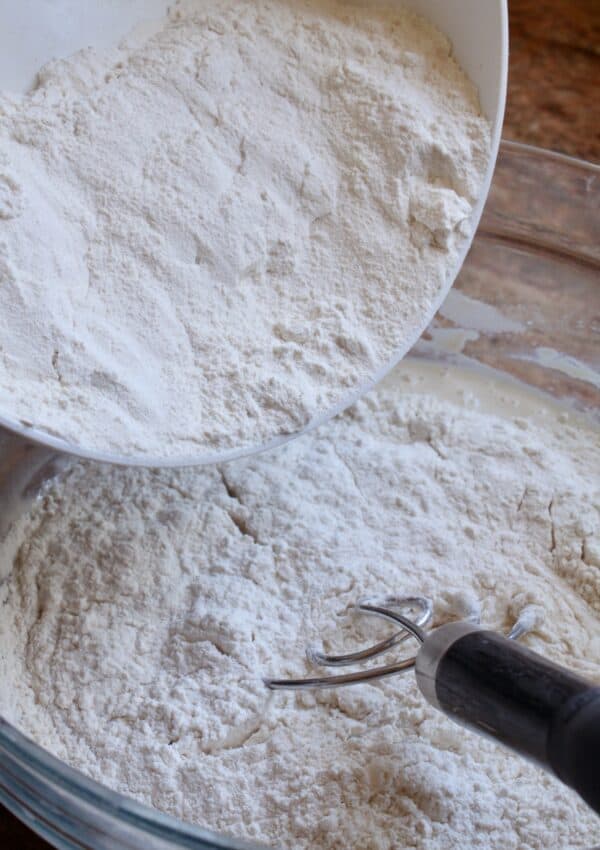
Mix just for a few seconds, then turn out onto a board or counter to mix by hand. After it all comes together (it will be very sticky) turn the bowl upside down over it and let it rest for 15 minutes.
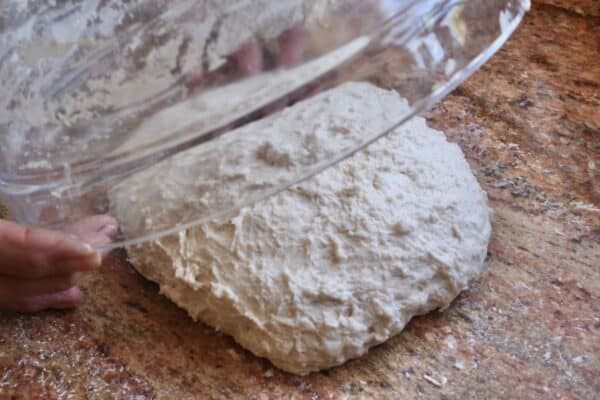
Prepping the Dough and the First Rise.
After 15 minutes, put some oil on your hands and take the dough up with both hands underneath and allow the two ends to fall, creating an air pocket inside. Continue to pick up the dough and repeat this process, turning a quarter turn each time (Vito’s video below will help with this step). Oil the original bowl and place the dough in the bowl, always keeping the top side up. Allow to rise for an hour.
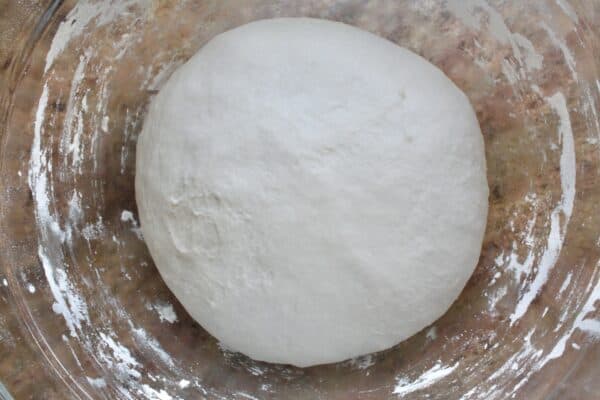
Making Balls of Homemade Pizza Dough and Second Rise.
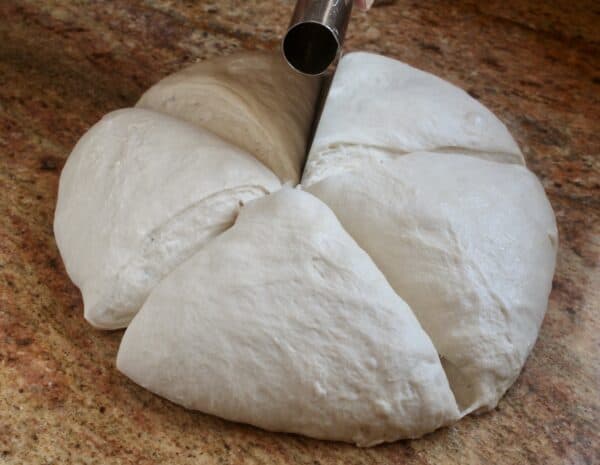
Next, cut into 5 equal sized pieces.

Fold and roll the pieces into balls, being sure to keep the top facing upwards when you are finished.
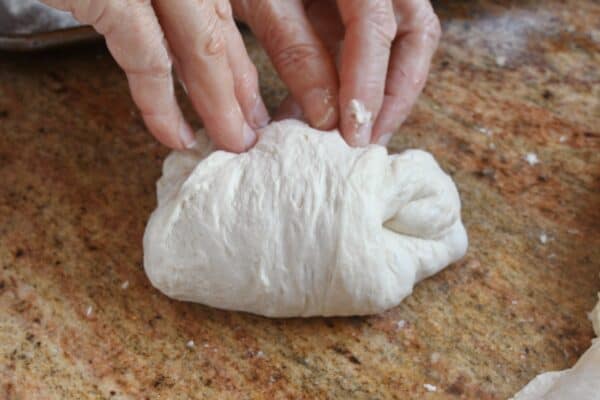
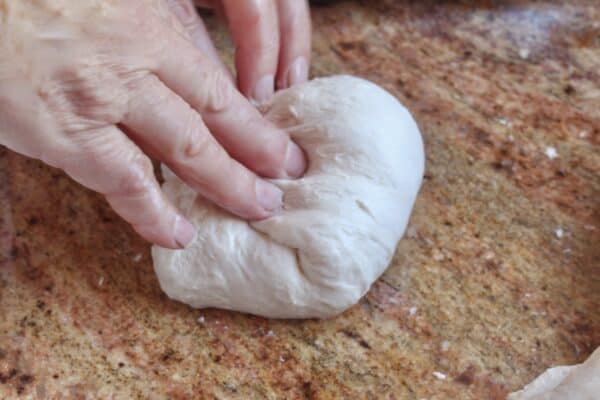
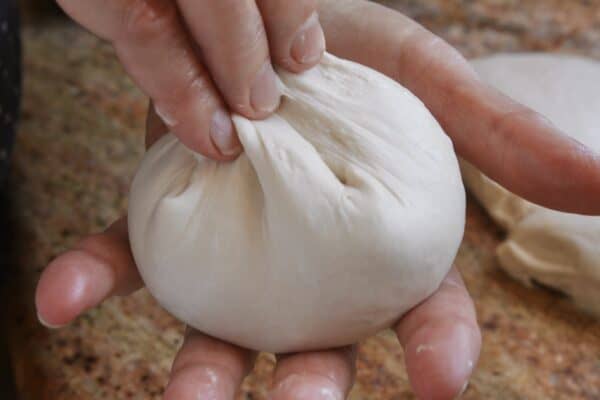
Place them on a tray sprinkled with fine semolina flour, or flour so that it doesn’t stick.

Top each ball with a little olive oil, cover with plastic wrap.

Alternatively, place in the oven (without turning it on) and place a jug of boiling water inside with the tray. Allow to rise for two more hours.
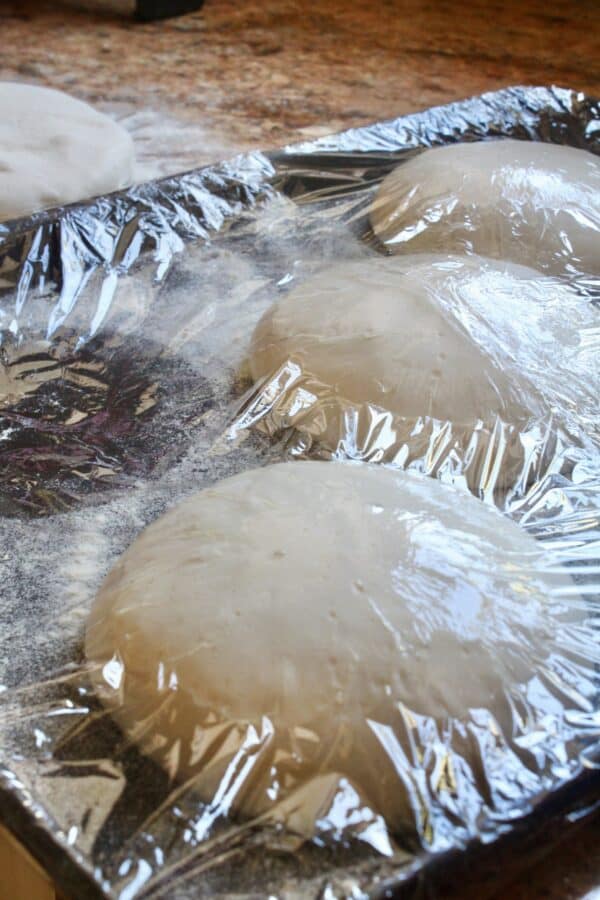
If using a pizza stone, put it in the oven and turn on the oven to an hour before the pizza is ready. This will ensure the pizza stone is super hot. If using a countertop pizza oven, there’s no need to heat it up this early.
Shaping the Pizza Dough
After two hours, take one ball of homemade pizza dough and put in on some semolina flour, top and bottom, always keep it right side up when you finish. Start pushing the dough in the center towards the edges.
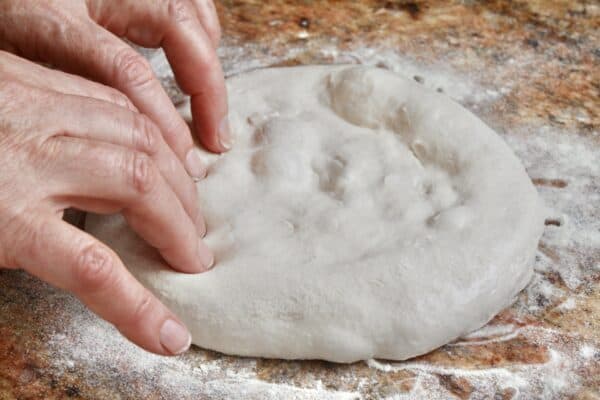
If you have an indoor countertop pizza oven (this one is similar to the one I have) you want to have the dough on the pizza peel at this point.
Top and Bake the Homemade Pizza Dough
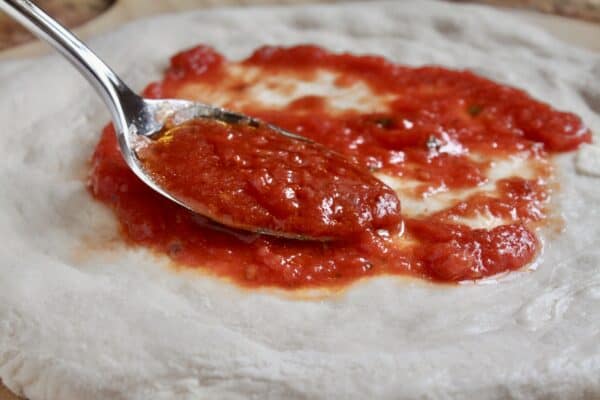
I strongly suggest using this pizza sauce recipe. This is how Vito makes his sauce, too. He also suggest oiling the edge. Check out my Italian tomato factory tour to understand why Italian canned tomatoes are the best quality you can buy.
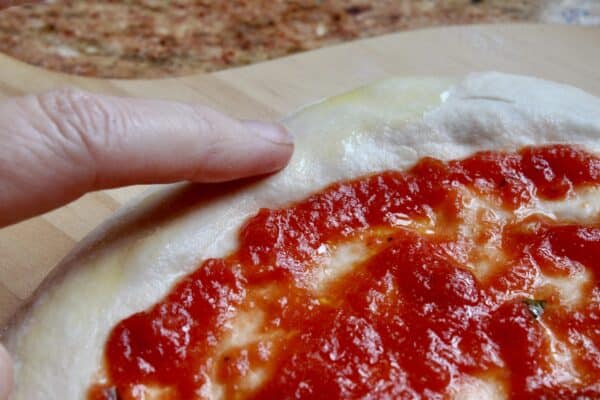
I use a counter-top pizza oven, but you can use a pizza stone as Vito does in his video tutorial.

Add the toppings you desire and bake according to your pizza oven, oven with stone or counter top oven directions. This mushroom, truffle, brie and arugula pizza is one of my favorite ways to top pizza that doesn’t include tomato sauce.
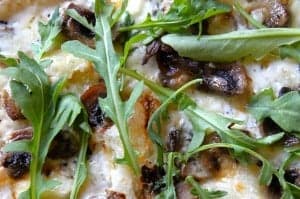
Finishing and serving the pizza.
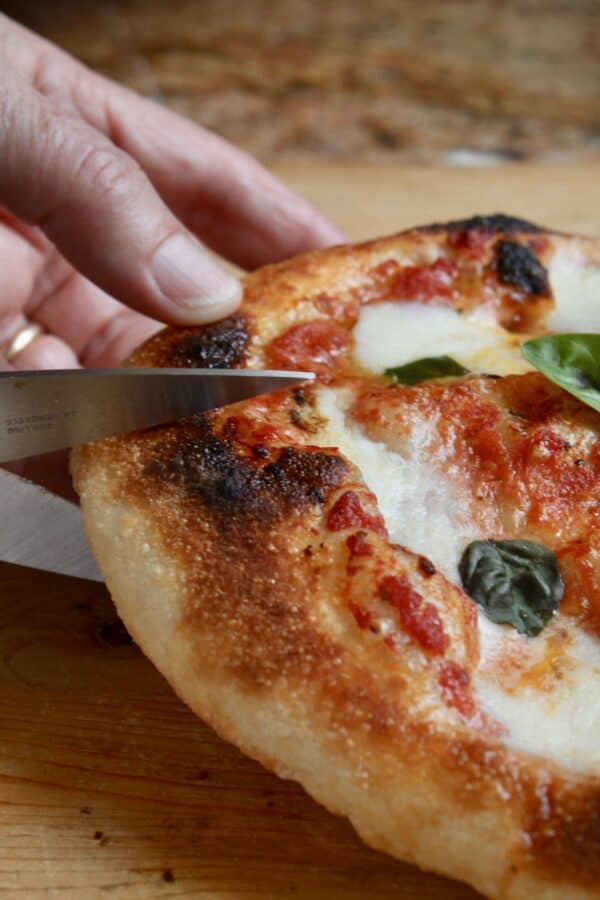
Cutting pizza with kitchen shears works really well. See the holes in the pizza crust? Again, my pizza is nothing like Vito’s yet, but I’m working on getting there and you can, too!

Let me know what you think if you try this recipe. Also be sure to subscribe to Vito’s YouTube channel and give him a thumbs up!
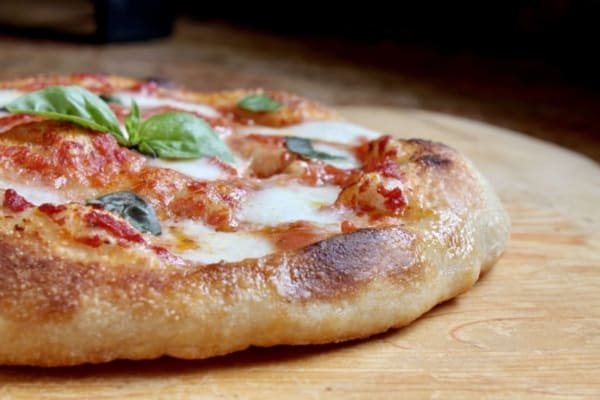
Watch Vito’s video on how to make perfect pizza dough at home. Printable recipe below.
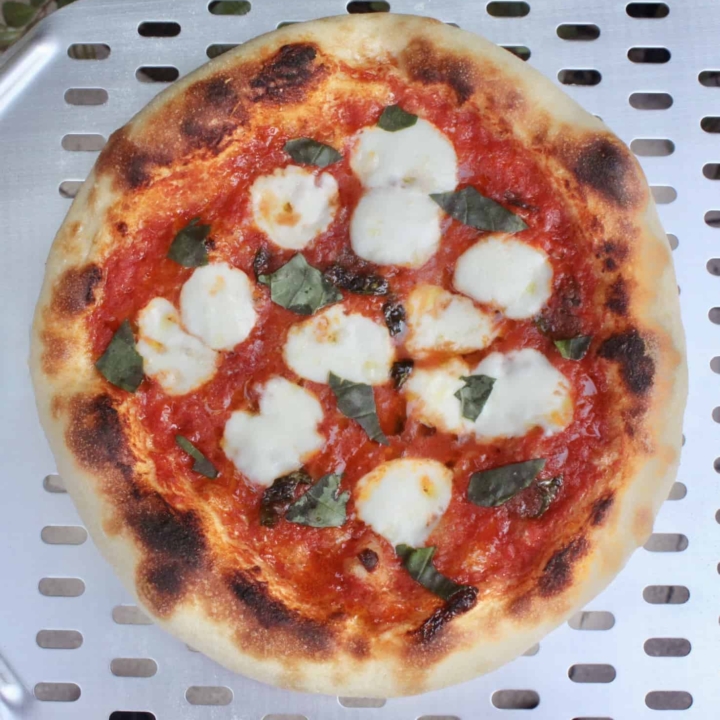
Best Homemade Pizza Dough Recipe (Authentic Neapolitan Style)
The best homemade pizza dough recipe you'll every make!
Ingredients
Poolish
- 150 ml water
- 150 g 00 Italian flour (double zero flour is the best for pizza-making, and I highly recommend it) or all-purpose or bread flour
- 3 g dry yeast
- 3 g honey
Dough
- all the poolish (after 24 hours)
- 375 ml water
- 625 g 00 Italian flour
- 20 g (2 Tbsp) Kosher or sea salt
Instructions
Make the Poolish
- Mix all the poolish ingredients (weighed on a scale) together in a small glass or plastic container until it has a uniform consistency. Leave at room temperature for one hour.
- After an hour, place in the fridge for 24 hours.
THE NEXT DAY: Make the Dough
- Put the water for the dough into a large bowl then add all of the poolish. Mix together until the poolish loosens and mixes into the water.
- Next, add half of the flour and mix well (I like to use a Danish whisk).
- Add the salt.
- Then add the remaining flour.
- Mix just for a few seconds, then turn out onto a board or counter to mix by hand. After it all comes together (it will be very sticky) turn the bowl upside down over it and let it rest for 15 minutes.
Prepping the Dough and the First Rise.
- After 15 minutes, put some oil on your hands and take the dough up with both hands underneath and allow the two ends to fall, creating an air pocket inside. Continue to pick up the dough and repeat this process, turning a quarter turn each time (Vito's video below will help with this step).
- Oil the original bowl and place the dough in the bowl, always keeping the top side up. Allow to rise for an hour.
Making Balls of Homemade Pizza Dough and Second Rise.
- Next, cut into 5 equal sized pieces.
- Fold and roll the pieces into balls, being sure to keep the top facing upwards when you are finished.
- Place them on a tray sprinkled with fine semolina flour, or flour so that it doesn't stick.
- Top each ball with a little olive oil, cover with plastic wrap.
- Alternatively, place in the oven (without turning it on) and place a jug of boiling water inside with the tray. Allow to rise for two more hours.
- If using a pizza stone, put it in the oven and turn on the oven to 500F (260C) or as hot as it can be set, an hour before the pizza is ready. This will ensure the pizza stone is super hot. If using a countertop pizza oven, there's no need to heat it up this early.
Shaping the Pizza Dough
- After two hours, take one ball of homemade pizza dough and put in on some semolina flour, top and bottom, always keep it right side up when you finish. Start pushing the dough in the center towards the edges.
- If you have an indoor countertop pizza oven, you want to have the dough on the peel at this point. Follow the directions of your pizza cooker.
Top and Bake the Homemade Pizza Dough
- I strongly suggest using this pizza sauce recipe. This is how Vito makes his sauce, too. He also suggest oiling the edge. Check out my Italian tomato factory tour to understand why Italian canned tomatoes are the best quality you can buy.
- I use a counter-top pizza oven, but you can use a pizza stone as Vito does in his video tutorial.
- Add the toppings you desire and bake according to your pizza oven, oven with stone or counter top oven directions. This mushroom, truffle, brie and arugula pizza is one of my favorite ways to top pizza that doesn't include tomato sauce.
Finishing and serving the pizza.
- Cutting pizza with kitchen shears works really well. See the holes in the pizza crust? Again, my pizza is nothing like Vito's yet, but I'm working on getting there and you can, too!
- Let me know what you think if you try this recipe. Also be sure to subscribe to Vito's YouTube channel and give him a thumbs up!
Notes
Please use the best quality ingredients you can find, and be aware of the timeline needed to make this pizza. It's WELL worth the planning.
I recommend starting the poolish a few hours before the time you want to enjoy your pizza the next day. For example, start it on Friday afternoon if you want to have pizza for dinner on Saturday.
Nutrition Information:
Yield: 5 Serving Size: 1Amount Per Serving: Calories: 103Total Fat: 1gSaturated Fat: 0gTrans Fat: 0gUnsaturated Fat: 0gCholesterol: 0mgSodium: 2331mgCarbohydrates: 21gFiber: 1gSugar: 1gProtein: 4g
Nutrition information is only estimated and is only for the dough.
Christina’s Cucina is a participant in the Amazon Services LLC Associates Program, an affiliate advertising program designed to provide a means for sites to earn advertising fees by advertising and linking to Amazon.com.


Christina, it’s amazing how some people just reject the option of accuracy, your recipes are right on and they are wonderful! I’ve been watching Vito’s channel for a while now and nothing comes close to his methods. If anybody wants a truly wonderful Pizza, follow the directions exactly, and use a scale 🙂
Your ridiculous statement about measurements must be addressed.
No measurements are so critical that US standard, metric or a bohemian derivative can’t be used. Grams, molecular weights or teaspoons will suffice for any recipe.
You and your European weights & measurement system is not superior or more exact than even a simple scale used in Asia, a cupped hand or any other weight & measurement system used on this entire planet.
Your idea of that CRITICAL need is indeed ridiculous….
It is obvious that you are not any type of teacher, let alone a professor, and do not cook or bake. Scales are imperative for the best results in this recipe.
Hear, hear!
Grazie!
Oops, 4 teaspoons, not 2 teaspoons.
This recipe is perfect except 20 grams of salt isn’t 2 tablespoons unless you are using bigger flaked salt. I used Aurora Mediterranean Fine Sea salt from Italy and 20 grams was about 2 teaspoons. Again, scale is sooooo important when baking.
I cut into 4 dough balls instead of 5 and made it a little thicker in the middle, like Roman style. So crunchy and chewy. LOVE LOVE LOVE!!!!!
Your measurements were spot on. I watched Vito’s video for the directions since you kinda stopped the instruction during the shaping of the dough.
Thank you soooo very much for sharing this recipe. Brings back good memories of my grandma. I noticed you have the sugar bread recipe from the leftover dough, my favorite as a little girl.
Glad you liked it, Esme!
Can you freeze the dough?
Yes! Vito has a video on how to freeze and also defrost!
After cutting the dough and making balls, can you refrigerate until using later?
If you are going to post your recipes on Pinterest at least have the common sense and courtesy to not use metric measurements. The last I heard the. US had not adopted the metric system
Having followed everything exactly along with converting the measurements and rechecking everything twice before mixing along with proof / rise times I have a solid Nass of flour that rose very little and is solid as a rock
I this recipe was a waste of money at the expense of the flour and the 26 hours of my life I will never getting back
Invest in a $10 scale and you’ll be delighted with this recipe! :)
Here is one of many links to help you convert your measurements:https://www.convertunits.com/from/cups/to/grams
As a baker, I appreciate when recipes are given in metric measurements instead of the Imperail System of measurement. It is much more accurate.
No conversion chart will help, Vivian. A scale is really necessary for good results.
Neither have Liberia or Myanmar. So? The last I heard, people can learn.
First, Pinterest is an internationally used site. Second, it is incredibly cheap, easy, and accurate to use a scale. Converting is not the same as using the actual scale. Honestly, not being amendable to the metric system shows that one does not venture out enough in cooking/baking. Using a scale is the most accurate way to cook, along with feel. “British units” are probably the least. There are so many international recipes worth trying that if you are adventurous, you would buy a scale on Amazon for $12. This opens your culinary skills to a whole new level when you are able to follow any recipe out there on the internet. Being upset when you see a recipe using metric measurements is like being upset when people expect you to at least try to speak something of their language when you are in their country. This blog showcases international dishes, thus international measurements as well, which thankfully are incredibly translateable with a simple scale that any serious cook would have.
You explained this so well, Maria. Thank you!
I have been making pizza dough for many years, both at home and in a restaurant, albeit decades ago as a kitchenhand. I thought that I had it covered! This recipe is a beauty, and has set a new benchmark for me. While one needs to plan well ahead, this is the path to the light yet chewy pizzas of Napoli. I feel as though I am on a new pizza odyssey!
Isn’t it incredible? My family in Italy didn’t make the dough this way, so I feel the same as you! Vito is such an inspiration, good luck, Nicko!